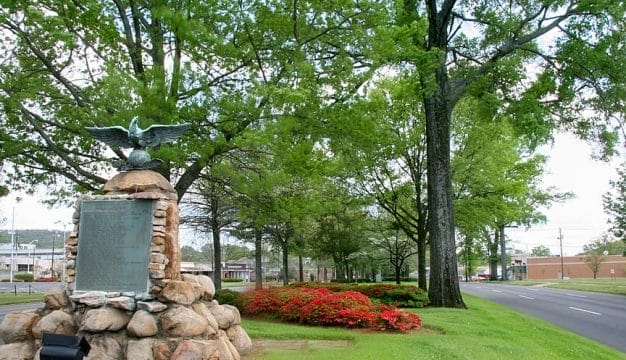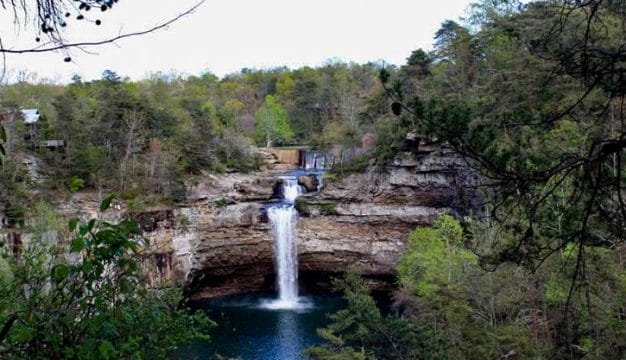Lamar County
 Jerry Brown
Located in the northwest part of the state, Lamar County was created during Reconstruction and underwent several name changes. Famed Alabama folk potter Jerry Brown and several members of the influential political Bankhead family were born in Sulligent, and Muscle Shoals musician Dan Penn was born in Vernon. Lamar County is governed by an elected, five-member commission and includes six incorporated communities.
Jerry Brown
Located in the northwest part of the state, Lamar County was created during Reconstruction and underwent several name changes. Famed Alabama folk potter Jerry Brown and several members of the influential political Bankhead family were born in Sulligent, and Muscle Shoals musician Dan Penn was born in Vernon. Lamar County is governed by an elected, five-member commission and includes six incorporated communities.
- Founding Date: February 4, 1867
- Area: 605 square miles
- Population: 13,854 (2020 Census estimate)
- Major Waterways: Tombigbee River
- Major Highways: U.S. 278
- County Seat: Vernon
- Largest City: Sulligent
History
 Lucius Quintus Cincinnatus Lamar
Lamar County was created by an act of the Alabama State Legislature on February 4, 1867. During the tumultuous Reconstruction Era, Lamar County was formed from the southern portion of Marion County and the western portion of Fayette County. The county was originally named Jones County in honor of Fayette County resident E. P. Jones. On November 13, 1867, the county was abolished and the lands returned to Marion County. Less than a year later, however, the county was reestablished on October 8, 1868. This time, the county was named Sanford County, in honor of H. C. Sanford of Cherokee County. The name of the county changed for a third and final time on February 8, 1877. At that time, Sanford County became Lamar County in honor of Sen. Lucius Quintus Cincinnatus Lamar of Mississippi. Most of Lamar County’s settlers came from South Carolina, Georgia, and Tennessee, and many of them made their way to the area that would become Lamar County via Gen. Andrew Jackson’s Military Road . Some of the county’s earliest towns included Vernon (formerly known as Swayne), Sulligent, and Beaverton.
Lucius Quintus Cincinnatus Lamar
Lamar County was created by an act of the Alabama State Legislature on February 4, 1867. During the tumultuous Reconstruction Era, Lamar County was formed from the southern portion of Marion County and the western portion of Fayette County. The county was originally named Jones County in honor of Fayette County resident E. P. Jones. On November 13, 1867, the county was abolished and the lands returned to Marion County. Less than a year later, however, the county was reestablished on October 8, 1868. This time, the county was named Sanford County, in honor of H. C. Sanford of Cherokee County. The name of the county changed for a third and final time on February 8, 1877. At that time, Sanford County became Lamar County in honor of Sen. Lucius Quintus Cincinnatus Lamar of Mississippi. Most of Lamar County’s settlers came from South Carolina, Georgia, and Tennessee, and many of them made their way to the area that would become Lamar County via Gen. Andrew Jackson’s Military Road . Some of the county’s earliest towns included Vernon (formerly known as Swayne), Sulligent, and Beaverton.
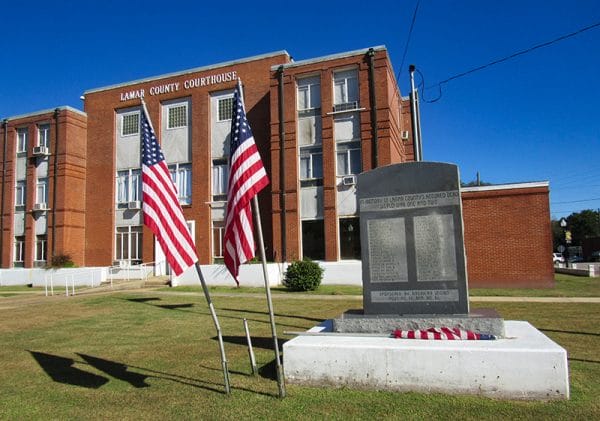 Lamar County Courthouse
In 1866, the community of Swayne was designated as the first county seat of Lamar County. Swayne was named for Union general Wager Swayne, who served as Alabama’s governmental leader during Congressional Reconstruction. When Lamar County was recreated in 1868, the community changed its name to Vernon after Edmund Vernon, an immigrant from Vernon, England. The first courthouse in Vernon occupied the site of the present-day structure. The original courthouse was a two-story frame building of brick that was replaced around 1909 with a larger, more modern building featuring huge white columns with Doric capitols. In 1950, the columns were removed during a renovation and a third floor was added. The structure remains the county courthouse.
Lamar County Courthouse
In 1866, the community of Swayne was designated as the first county seat of Lamar County. Swayne was named for Union general Wager Swayne, who served as Alabama’s governmental leader during Congressional Reconstruction. When Lamar County was recreated in 1868, the community changed its name to Vernon after Edmund Vernon, an immigrant from Vernon, England. The first courthouse in Vernon occupied the site of the present-day structure. The original courthouse was a two-story frame building of brick that was replaced around 1909 with a larger, more modern building featuring huge white columns with Doric capitols. In 1950, the columns were removed during a renovation and a third floor was added. The structure remains the county courthouse.
Major Cities and Demographics
According to 2020 Census estimates, the population of Lamar County was 13,854. Approximately 87.4 percent of respondents identified themselves as white, 11.0 percent as African American, 1.7 percent Hispanic, 1.0 percent as two or more races, 0.2 percent as Asian, and 0.1 percent as American Indian. The largest city in Lamar County is Sulligent, with an estimated of population of 1,887. Other significant population centers include Vernon and Millport. The median household income was $42,688, compared with $52,035 for the state as a whole, and the per capita income was $22,299, compared with $28,934 for the state as a whole.
Economy
During the 1830s and 1840s, small-scale farming typified the area that would become Lamar County. Corn, potato, and livestock production were always more important than cotton production, although an increase in cotton production occurred in the 1850s. With access to the Tombigbee River, farmers in the area that would become Lamar County shipped their goods southward to New Orleans and Mobile markets.
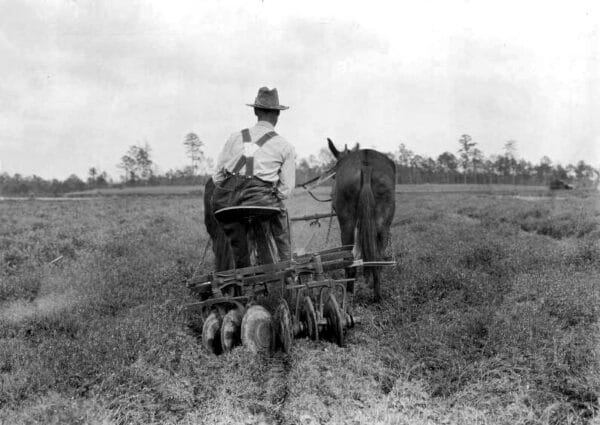 Lamar County Farm
Lamar County was created during Reconstruction, and thus the county had to immediately contend with the economic aftermath of the Civil War. Timber production as well as tanneries and lumber mills provided a boost to the county’s economy during the late nineteenth and early twentieth centuries, but Lamar County remained poor and isolated up until World War II. During the 1930s and 1940s, hydroelectric power provided some relief for the county’s workforce, as Lamar County attempted to industrialize. The county met with limited success, however, and in recent decades many of the factories in the county (especially garment factories) have closed.
Lamar County Farm
Lamar County was created during Reconstruction, and thus the county had to immediately contend with the economic aftermath of the Civil War. Timber production as well as tanneries and lumber mills provided a boost to the county’s economy during the late nineteenth and early twentieth centuries, but Lamar County remained poor and isolated up until World War II. During the 1930s and 1940s, hydroelectric power provided some relief for the county’s workforce, as Lamar County attempted to industrialize. The county met with limited success, however, and in recent decades many of the factories in the county (especially garment factories) have closed.
Employment
According to 2020 Census estimates, the workforce in Lamar County was divided among the following industrial categories:
- Manufacturing (28.2 percent)
- Educational services, and health care and social assistance (18.8 percent)
- Other services, except public administration (8.2 percent)
- Public administration (7.8 percent)
- Retail trade (7.3 percent)
- Finance and insurance, and real estate, rental, and leasing (6.2 percent)
- Professional, scientific, management, and administrative and waste management services (6.1 percent)
- Construction (4.6 percent)
- Wholesale trade (4.0 percent)
- Agriculture, forestry, fishing and hunting, and extractive (3.1 percent)
- Transportation and warehousing, and utilities (2.9 percent)
- Arts, entertainment, recreation, and accommodation and food services (2.0 percent)
- Information (0.9 percent)
Education
The Lamar County School System oversees five primary and secondary schools.
Geography
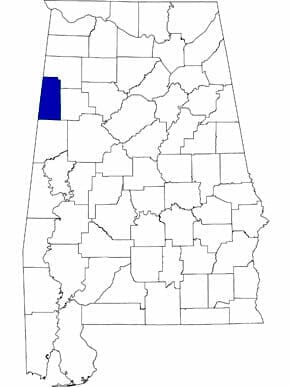 Lamar County Map
Comprised of slightly more than 600 square miles, Lamar County is located in the northwest part of Alabama. The county is part of the Coastal Plain physiographic section and sits on sections of the Warrior Coal Basin in the Warrior Coal Field. Oak and pine forests dot the county’s landscape of shallow and sandy soils. Lamar County is bordered to the north and west by Marion County, to the east by Fayette County, to the south by Pickens County, and to the west by the state of Mississippi.
Lamar County Map
Comprised of slightly more than 600 square miles, Lamar County is located in the northwest part of Alabama. The county is part of the Coastal Plain physiographic section and sits on sections of the Warrior Coal Basin in the Warrior Coal Field. Oak and pine forests dot the county’s landscape of shallow and sandy soils. Lamar County is bordered to the north and west by Marion County, to the east by Fayette County, to the south by Pickens County, and to the west by the state of Mississippi.
The Upper Tombigbee Watershed of the Tombigbee River drains all of Lamar County. Tributaries of both the Buttahatchee River and Luxapallila Creek flow throughout the county, offering both recreational and economic opportunities. The Tombigbee River is considered one of the most critical watersheds in the nation, with more than 125 species of fish, 10 of which are considered endangered.
U.S. Highway 278 is Lamar County’s only interstate highway and runs east-west across the northern half of the county. State Route 17 runs north-south through the middle of Lamar County, and State Route 18 runs east-west through the middle of the county. State Route 96 runs east-west across the southern half of Lamar County. The Lamar County Airport in Vernon is the county’s only public airport.
Events and Places of Interest
 The Ogden House
There are several recreational opportunities for visitors to Lamar County. The Sam R. Murphy Wildlife Management Area, formerly known as the Lamarion Wildlife Management Area, is located along the northern border of the county and encompasses 25,150 acres of grassy woodlands. Visitors to the area can hunt both small and large game as well as fish. The Quail Valley Hunting Preserve in Vernon also affords visitors the opportunity to hunt quail. Open each October through March, the preserve offers both walking hunts and wagon ride hunts.
The Ogden House
There are several recreational opportunities for visitors to Lamar County. The Sam R. Murphy Wildlife Management Area, formerly known as the Lamarion Wildlife Management Area, is located along the northern border of the county and encompasses 25,150 acres of grassy woodlands. Visitors to the area can hunt both small and large game as well as fish. The Quail Valley Hunting Preserve in Vernon also affords visitors the opportunity to hunt quail. Open each October through March, the preserve offers both walking hunts and wagon ride hunts.
 Moore-Hill House
The James Greer Bankhead House (ca. 1850) in Sulligent is listed on the National Register of Historic Places, and several homes, including the Dick Mixon Farm (1899) and the Ogden House (1888), are listed on the Alabama Register of Landmarks and Heritage. The privately owned Moore-Hill House, built in 1834, is believed to be the oldest house in Lamar County. In April, Vernon hosts the annual Vernon City Celebration. The festival includes food and music as well as games and rides. Each Saturday night in Vernon, the Backstreet Opry hosts a variety of shows that are free and open to the public. Entertainers, both professional and amateur alike, sing and play a variety of music from country to gospel to blues. The facility also hosts comedy shows.
Moore-Hill House
The James Greer Bankhead House (ca. 1850) in Sulligent is listed on the National Register of Historic Places, and several homes, including the Dick Mixon Farm (1899) and the Ogden House (1888), are listed on the Alabama Register of Landmarks and Heritage. The privately owned Moore-Hill House, built in 1834, is believed to be the oldest house in Lamar County. In April, Vernon hosts the annual Vernon City Celebration. The festival includes food and music as well as games and rides. Each Saturday night in Vernon, the Backstreet Opry hosts a variety of shows that are free and open to the public. Entertainers, both professional and amateur alike, sing and play a variety of music from country to gospel to blues. The facility also hosts comedy shows.
As a member of the Northwest Alabama Arts Council, Lamar County is a sponsor of the Jerry Brown Arts Festival, which takes place annually in nearby Hamilton, in Marion County. The council is a voluntary organization formed to promote the exploration of local artists and their work within a four-county area in northwest Alabama.
Further Reading
- Carruth, Barbara Woolbright. Lamar County. Charleston, S.C.: Arcadia, 2000.
- The Heritage of Lamar County, Alabama. Clanton, Ala.: Heritage Publishing Consultants, 2000.
